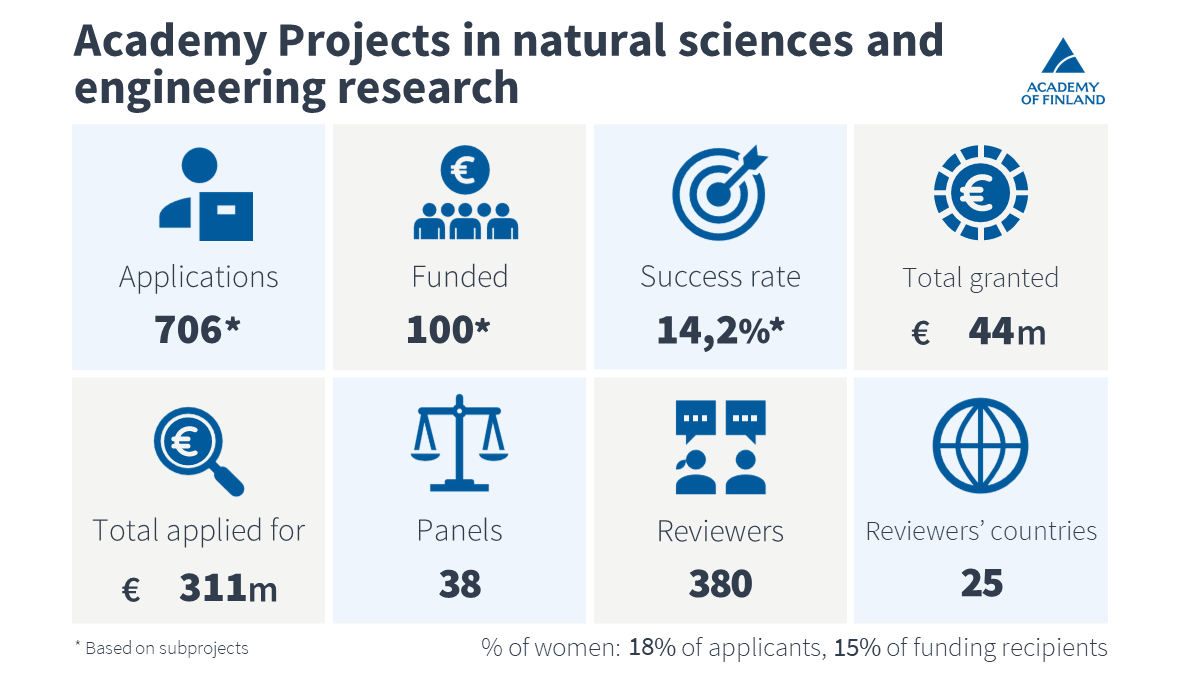Academy Project funding granted to scientifically and socially high-impact research in natural sciences and engineering
The Academy of Finland’s Research Council for Natural Sciences and Engineering today granted funding for 72 Academy Projects. The projects include more than a hundred subprojects. The total funding comes to around 44 million euros. In the funding decisions, the Research Council put particular emphasis on scientific quality, novelty, breakthrough potential and feasibility.
The quality of Academy Project applications addressed to the Research Council for Natural Sciences and Engineering has risen year by year. In this round, as many as 51 per cent of the applications were reviewed by international experts as excellent (overall rating 6 or 5). Of the projects that received the highest rating 6 about 74 per cent were funded. In comparison, only about 10 per cent of those that received the second highest rating 5 could be funded.
Academy Project Funding is among the Research Council’s most important funding instruments for promoting the quality, impact and renewal of research. The Research Council aims to fund research in a wide range of fields within natural sciences and engineering and to take into account the special characteristics of each field.
Reko Leino, the Chair of the Research Council, said: “The number of Academy Project applications has been on the rise in recent years. However, there’s room for even more applications in areas of national importance, such as process engineering, environmental engineering and mechanical engineering and manufacturing technology, to ensure the success of these fields and the future regeneration of the research community.”
Of the highly rated applications, 14.5 per cent were from early-career researchers. In turn, early-career researchers accounted for 24 per cent of the subprojects selected for funding. The Research Council funded subprojects of early-career researchers with a total of just over 11 million euros, of which some 9 million euros came from funds especially earmarked for early-career researchers. An applicant was considered to be an early-career researcher if no more than ten years had passed since their first doctoral degree.
Examples of funded projects
Clemens Icheln (Aalto University) was granted funding for a project that aims to develop improved capsule endoscope electronics in order to improve the diagnostic yield. Capsule endoscopes have gained popularity in inspecting the digestive tract mainly because of their low level of invasiveness. The present challenge of the capsule endoscope is its limited diagnostic reliability. The limited reliability is attributed to a limited field-of-view by the camera in the capsule, the limited capacity of the wireless data transfer from the capsule to outside the body and to the limited capacity of the battery. To solve this challenge, Icheln proposes new radio frequency and optical components and associated capsule functionalities.
Mari Kallioinen (LUT University) and Tuomo Laitinen (University of Eastern Finland) received funding for a project developing novel modification routes that enable the production of membranes with antibiofouling characteristics. Natural phenolic compounds, available for instance in underutilised biomass fractions, will be used as the modification agents. The research will involve a combination of modelling and experimental research to shed light on interactions between phenolic compounds, membrane surface and micro-organisms. The results of the project will be used to develop antibiofouling strategies to prevent biofouling in wastewater treatment.
Aki Virkkula (Finnish Meteorological Institute), Olli Sippula (University of Eastern Finland), Mikko Savolahti (Finnish Environment Institute), and Tuomas Hieta (University of Helsinki) received funding for a consortium project estimating the contributions of both black carbon and brown carbon to the radiative forcing of the climate especially in Finland but also in a wider boreal context. The work will include measuring contributions of black carbon and brown carbon to light absorption in the UV-Vis wavelength range. Fossil fuel and biomass burning contributions will be estimated by carbon isotope analyses. Measurements will be conducted in different parts of Finland, and long-term filter samples collected in Svalbard, Siberia and the Alps will be analysed. Emission inventories will be updated by using measured black carbon and brown carbon emission factors and used for updating emission scenarios and estimating the radiative forcing of black carbon and brown carbon for the period 2020–2100.

Inquiries and more information
- List of funded projects
- Funding criteria and policies of the Research Council for Natural Sciences and Engineering
- Jenni Heino, Science Adviser, tel. +358 295 335 030
- Ulrika Jakobsson, Science Adviser, tel. +358 295 335 038
- Hanne Laine-Kaulio, Science Adviser, tel. +358 295 335 124
- Timo Lehtinen, Science Adviser, tel. +358 295 335 054
- Katrine Mahlamäki, Science Adviser, tel. +358 295 335 062
- Oskari Miettinen, Science Adviser, tel. +358 295 335 053
Our email addresses are in the format firstname.lastname(at)aka.fi.
Academy of Finland Communications
Vesa Varpula, Communications Specialist
tel. +358 295 335 131
firstname.lastname(at)aka.fi